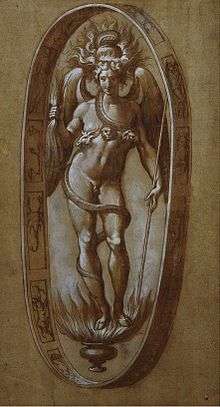Phanes
Phanes /ˈfeɪˌniːz/ (Ancient Greek: Φάνης, genitive Φάνητος) or Protogonus /proʊˈtɒɡənəs/ (Ancient Greek: Πρωτογόνος, "first-born") was the mystic primeval deity of procreation and the generation of new life, who was introduced into Greek mythology by the Orphic tradition; other names for this Classical Greek Orphic concept included Ericapaeus /ˌɛrɪkəˈpiːəs/ or Erikepaios (Ἠρικαπαῖος/Ἠρικεπαῖος "power") and Metis ("thought").[1][2]
| Phanes | |
|---|---|
God of Creation | |
 A 16th-century illustration of Phanes by Francesco de' Rossi | |
| Symbol | Serpent |
| Personal information | |
| Parents | Chronos and Ananke or Nyx |
| Siblings | Chaos, Moirai, Horae |
Mythology
Orphic cosmogony
In these myths, Phanes is often equated with Eros and Mithras and has been depicted as a deity emerging from a cosmic egg, entwined with a serpent. He had a helmet and had broad, golden wings. The Orphic cosmogony is bizarre, and quite unlike the creation sagas offered by Homer and Hesiod. Scholars have suggested that Orphism is "un-Greek" even "Asiatic" in conception, because of its inherent dualism.[3]
Chronos (Time) is said to have created the silver egg of the universe, out of which burst the androgynous[2] first-born deity Phanes, or Phanes-Dionysos.[4] Phanes is said to have both a phallus and a vagina.[2] Phanes was a deity of light and goodness, whose name meant "to bring light" or "to shine"; a first-born god of light who emerged from a void or a watery abyss and gives birth to the universe.[5] Nyx (Night) is variously said to be Phanes' daughter[4] or older wife.
Many threads of earlier myths are apparent in the new tradition. Phanes was believed to have been hatched from the World-Egg of Chronos (Time) and Ananke (Necessity or Fate) or Nyx in the form of a black bird and wind. His older wife Nyx called him Protogenus. As she created nighttime, Phanes created daytime, and also created the method of creation by mingling. He was made the ruler of the deities and passed the sceptre to Nyx. This new Orphic tradition states that Nyx later gave the sceptre to her son Uranos before it passed to Cronus and then to Zeus, who retained it.
According to Aristophanes, whence Phanes is called Eros, he was born from an egg created by Nyx and placed in the boundless lap of Erebus, after which he mates with Chaos and creates the flying creatures.[6] This passage seeks to demonstrate that the flying creatures are considered older than all other living creatures, even older than the other gods.
Protogonos Theogony
The "Protogonos Theogony" is known through the commentary in the Derveni papyrus and references in Empedocles and Pindar.
According to Damascius, Phanes was the first god "expressible and acceptable to human ears" ("πρώτης ητόν τι ἐχούσης καὶ σύμμετρον πρὸς ἀνθρώπων ἀκοάς").[7]
Another Orphic hymn states:[8] "You scattered the dark mist that lay before your eyes and, flapping your wings, you whirled about, and throughout this world you brought pure light. For this I call you Phanes." ("ὄσσων ὃς σκοτόεσσαν ἀπημαύρωσας ὁμίχλην πάντη δινηθεὶς πτερύγων ῥιπαῖς κατὰ κόσμον λαμπρὸν ἄγων φάος ἁγνόν , ἀφ ' οὗ σε Φάνητα κικλήσκω.")
The Derveni Papyrus refers to Phanes: "Of the First-born king, the neverend[9] one; and upon him all the immortals grew, blessed gods and goddesses and rivers and lovely springs and everything else that had then been born; and he himself became the sole one".[10] ("Πρωτογόνου βασιλέως αἰδοίου∙ τῶι δ’ ἄρα πάντες ἀθάνατοι προσέφυν μάκαρες θεοὶ ἠδ̣ὲ θέαιναι καὶ ποταμοὶ καὶ κρῆναι ἐπήρατιο ἄλλα τε πάντα, ἅ̣σσα τότ’ ἦγγεγαῶτ’, αὐτὸς δ’ ἄρα μοῦνος ἔγεντο.”)
Dionysus or Zagreus of the Orphic tradition is intimately connected to Protogonos. In Orphic Hymn 30, he is given a list of epithets that also allude to Protogonos: "πρωτόγονον, διφυῆ, τρίγονον, Βακχεῖον ἄνακτα, ἄγριον, ἄρρητον, κρύφιον, δικέρωτα, δίμορφον"[11]
πρωτόγονον primeval διφυῆ two-natured τρίγονον thrice-born Βακχεῖον ἄνακτα Bacchic lord ἄγριον savage ἄρρητον ineffable κρύφιον secretive δικέρωτα two-horned δίμορφον two-shaped
In the Orphic tradition, Dionysus-Protogonos-Phanes is a dying and rising god. Eusebius tells us the story of his death and recreation. The Titans boil the dismembered limbs of Dionysus in a kettle, they roast him on a spit and eat the roasted "sacrificial meat", then Athena rescues the still-beating heart[12] from which (according to Olympiodorus)[13] Zeus is able to recreate the god and bring him back to life. Kessler has argued that this cult of death and resurrection of Dionysus developed the 4th century CE; and together with Mithraism and other sects this cult formed, were in direct competition with early Christianity during late Antiquity.[14]
See also
References
- Taylor, Thomas (1824). The Mystical Hymns of Orpheus (2nd ed.). Chiswick. p. xv.
- Santamaría Álvarez, Marco Antonio (2016). "Did Plato know of the Orphic god Protogonos?". In García Blanco, María José; Martín-Velasco, María José (eds.). Greek Philosophy and Mystery Cults. p. 207. ISBN 978-1-4438-8830-1.
- Russell, Jeffrey Burton (1987). The Devil: Perceptions of Evil from Antiquity to Primitive Christianity. Cornell University Press. p. 137. ISBN 0-8014-9409-5.
- Leeming, David Adams (2010). Creation Myths of the World: An Encyclopedia. p. 119. ISBN 978-1-59884-174-9.
- Greene, Liz (2000). The Astrological Neptune and the Quest for Redemption. Weiser Books. pp. 78–79.
- Aristophanes. The Birds. 690–702.
- cf. B. 75–80, K. 54
- Orphic Hymn 6, trans. Athanassakis (1977)
- "[no title cited]". greek-language.gr. Tools / Lexica.
- Kouremenos, Parássoglou, and Tsantsanoglou (2006)
- Orphic Hymn 30, trans. Athanassakis (1977) p.43
- Euseb. Praep. ev. 2.3.25 (K. 35)
- Olympiod. in Plat. Phaedon. 2.21 (K. 220)
- Kessler, E. (17–20 July 2006). Dionysian monotheism in Nea Paphos, Cyprus. Symposium on Pagan Monotheism in the Roman Empire (abstract). Exeter, UK. Archived from the original on 21 April 2008.
Sources
- Lang, Andrew (1887). . . 1. pp. 315–319 – via Wikisource.
- Iozzo, Mario (2012). "La kylix fiorentina di Chachrylion ed Eros Protogonos Phanes". Antike Kunst (55): 52–62.
- "Phanes". The Suda On Line: Byzantine Lexicography.